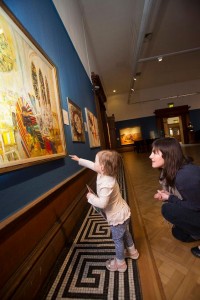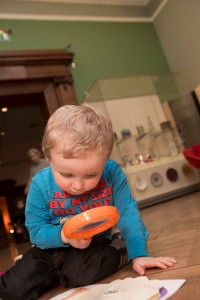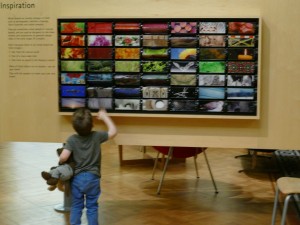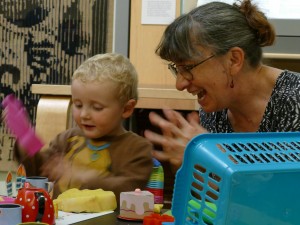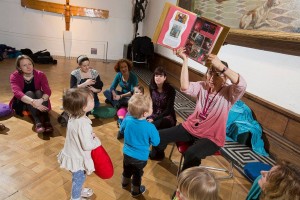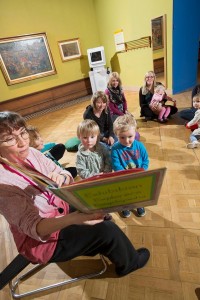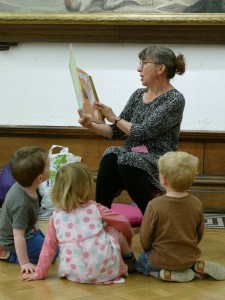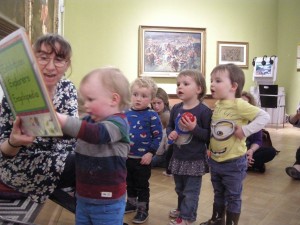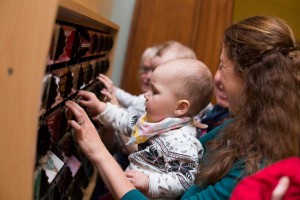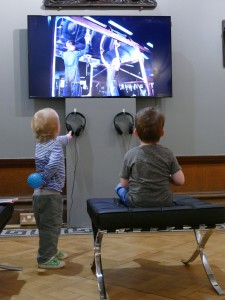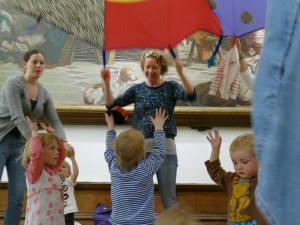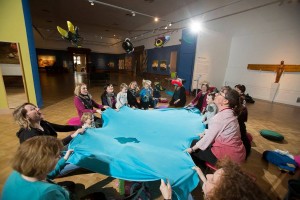Project Outline
Exhibition Explorers took place at the Shipley Art Gallery between February and July 2016. It was funded by Tyne and Wear Museums’ ‘Try New Things’ (TNT) initiative which supports new and experimental museum projects. There were a total of six sessions (one per month) attended by a cohort of sixteen 1 and 2 year olds and their parents and grandparents. The project focused on helping families to discover new ways of experiencing museums together. The sessions were planned and delivered by Claudia Knott, with support from Project Coordinator Hannah Mackay-Jackson and volunteers Sandra and Fiona. Families came together once a month for a lively facilitated session at the Shipley Art Gallery, combining songs, stories, parachute games, play, crafting and gallery-based ‘exploring activities’. The themes behind these activities were inspired by the Shipley’s collections. Each session was carefully designed to get children and adults looking at the artwork together, and exploring the gallery environment; for example, the families explored through treasure hunts; gallery walkabouts incorporating magnifying glasses, coloured viewfinders and pull-along toys; the opportunity for children to photograph something that interested them; and the planting of flags next to the children’s favourite things. Such activities were designed to build children’s familiarity with the gallery and engage them in the artworks. In addition, they aimed to increase parents’ confidence around engaging their child in museums, and help them see the visit through the children’s eyes.
Following these in-gallery sessions, families were encouraged to put these experiences into practice by visiting other museums and galleries independently. They were given ideas of places to visit, signposted to the Family Explorers North East website, and provided with coloured paper and glue sticks to assist them in recording their visits to other venues. At each session, children arrived eagerly clutching the scrapbook pages they’d created to record these ‘Family Adventures’. These were added to the big ‘Exhibition Explorers Encyclopedia’ and used by facilitator Claudia to create a story time with a difference, in which the families’ visits to cultural venues were celebrated and shared. This was also about encouraging exploratory attitudes to museum visits – for example, through their scrapbook pages, families frequently told us their children had enjoyed aspects of museums such as the lifts, open spaces, and the big windows. During the story time, these experiences were celebrated as much as the news that they’d visited a particular exhibition or engaged in a special event or learning activity, thereby emphasising the ‘exploring’ ethos of the project, and reinforcing this as a good way to approach a museum visit with a toddler. The Family Adventures were also added to the blog on the Shipley Art Gallery’s website, allowing parents to read about each other’s museum visits at their leisure, and for external audiences to learn about the project. The blog attracted interest from other museums and galleries and was shared by members of the UK’s museum sector via social media.
The Project’s Exploratory Ethos
The main ethos of the project was that museum and gallery visits for this age group should first and foremost be exploratory. Museum visits may be for entertainment, learning or other motivations, but exploring should be at the forefront of the experience. Parents were introduced to this ethos from the outset; they were told to follow their child’s lead and not worry if they weren’t joining in the group activity – for example, if a child wandered off from the singing sessions to investigate the gallery’s patterned floor; or wanted to crawl under a display case rather than looking at its contents, the parents should feel relaxed and comfortable and simply follow their child’s interest. Such behaviour was interpreted as a sign that the children were responding to the museum environment, and feeling interested and comfortable. By responding positively, staff and volunteers demonstrated that such behaviour was welcome, which helped parents to feel more relaxed about their child’s responses to the museum.
Session content was planned in ways that supported this exploring ethos: if children wandered off it was due to proactive interest in another aspect of the museum, not because the activity was too long, poorly structured, or too difficult for their age group. The ethos of exploring the museum was further supported by activities that encouraged this, such as treasure hunts and the opportunity for children to photograph something that interested them. The sessions were deliberately held in the gallery itself rather than a separate room (such as the Workshop which is often used by school groups, or the Lounge which is often used by community groups). This was to reassure parents that the children’s behaviour would be welcome throughout the gallery, and to increase confidence and familiarity with the gallery itself and hopefully encourage repeat visits between sessions and beyond the end of the project.
In their feedback, many parents commented on the exploring ethos of the project, showing its impact:
- ‘At first I thought other people in the gallery might not be too pleased if Fred suddenly scooted past them with the toys on wheels, but actually lots of people have been interested in what the children are doing. The staff are really friendly too so we feel that it’s okay for us to be here!’
- ‘She’ll choose an artwork to go and look at and then she’ll look carefully around it, at the floor and things. She’ll point at things she finds and show me too. And she loves the grandfather clock – she spent a long time looking carefully at it and asking to be picked up to see.’
- ‘We’ll come to the Shipley again, now we’ve been to this. We shouldn’t be scared to go in – that’s what I’ve realised from this project.’
The Families’ Starting Points
At the beginning of the project, two thirds of the group had visited the Shipley before. Of these, roughly half had attended baby groups there, such as Creative Baby, Hartbeeps classes, and Artventurers classes. Some of the parents had visited the Shipley without their children; one parent commented, ‘I’d been to the Shipley before for events like the Late Shows, but I wouldn’t really have considered it a place to come with a toddler’.
Almost half of the group said they take their child to a museum every month. A quarter said every 3-6 months, and a quarter said occasionally (holidays, special events etc.) Feelings about museums were positive: parents told us that they wanted their child to develop a love of museums; they felt museums had lots to offer their family; they felt sure their child would enjoy a museum visit; and that they believed the project would support their child’s learning and development.
Confidence about visiting museums was fairly high: almost two thirds of the group said they felt very confident about visiting a museum with their child. The other third said they felt somewhat confident and would like to develop. Several members of the group talked about the role museums could play in their parenting, and expressed an interest in coming to the project because it would help them to learn how to successfully incorporate museums into family life, and how to talk to their child about the displays.
Parents’ Expectations
At the beginning of the project and during the sessions, parents told us about their expectations for the project:
Many were keen to help their children develop a familiarity and fondness for museums, and to instil a sense of cultural entitlement – a sense that museums are for them:
- ‘I really want museums and galleries to be normal to her – I never went as a child, so I really want her to feel these are places for her.’
- ‘I really want my children to think of museums as nice spaces to play, visit, and have new experiences – that’s the message I really want to give them.’
- ‘She’ll learn about how you visit these places, then she’ll feel more confident that museums aren’t scary – they’re places she can follow her interests and really explore.’
- ‘This is a lovely opportunity to share what I love with my youngest child. Sadly we don’t go to museums together often. I love having one-to-one conversations with her about the things we see here.’
Others talked about their own learning, as opposed to their child’s. They wanted to incorporate museums more into family life, and felt that museums could play a role in their parenting practices. These parents wanted to consciously pick up skills and expertise through the project, to use when they visit museums as a family:
- ‘For both me and my child, it’s all about learning that it’s normal to go to places like this.’
- ‘I’m hoping to learn how to get the most out of museums, and make it as interesting as possible for my children.’
- ‘I’m hoping I’ll pick up more ideas of ways to talk to her about the displays.’
- ‘I’m really looking forward to doing something creative and a bit different with my toddler. I’m looking forward to finding new places and seeing how we could explore them together.’
Family Adventures
Between sessions, families were encouraged to visit a museum or gallery of their choice and to tell the group about the experience through scrapbooking. This peer-to-peer advocacy for museums was initially expected to be primarily of interest to the parents, and much thought was put into how we’d keep the children from getting restless while this information was conveyed to their parents. However, we were surprised to find that the children were extremely interested in this part of the session; they crowded around the Exhibition Explorers Encyclopaedia at story time, and eagerly told the group about where they’d been, without prompting.
As the families were creating the scrapbook pages, the tone was one of parent-to-parent feedback rather than institution-to-audience marketing. This meant that the sort of information that was shared was personalised to the toddlers, and frequently contained tips that would be useful to parents. Through their Family Adventures, the group shared feedback on aspects of their visit that matter to families, such as;
- Cafes and catering facilities (‘Best hot chocolate for kids ever!’; ‘There was space to eat our packed lunch’.)
- Facilities and recommendations for getting the most out of these (‘Play Tyne was great but a change of clothes would have been a good idea after all that splashing’; ‘If it had been warmer we’d have explored the beach near the Castle’; ‘The park next door is worth a visit too, we loved feeding the ducks’.)
- Unusual things their child had noticed (‘She was really interested in the toilets, and the light and dark spaces!’; ‘He was really struck by the scale of the Cathedral’.)
- Ways the visit related to their child’s other interests (‘We looked for the Gruffalo in the woods’; ‘The castle’s fireplace reminded him of the Stickman story we’ve been reading at home’.
- How they’d utilised the exploring ethos of the project (‘We spent lots of time using the water features as a toy, and going up the big steps because Evie had just learned to walk’; ‘We loved looking out of the big windows and going in the lift’; ‘We’ve realised you can make a toy out of anything!’).
- Ways the visit related to Exhibition Explorers sessions (‘Alex enjoyed using the magnifying glasses at Exhibition Explorers, and talked about it when he tried out the binoculars at the Grace Darling Museum’.)
- Learning and engagement resources (‘Fred loved pressing the buttons to change the lighting on the painting – very atmospheric’; ‘Zoe loved using the mirrors and mummy thought it was a good idea they were plastic so she didn’t need to worry about them getting broken!’)
Parents also fed back that visiting museums and galleries independently had allowed them to put into practice what they’d learned at the sessions. They had internalised the playful, exploratory ethos of the project:
- ‘Now we know that playing and exploring is a really good way to approach a museum, so we’re ok with it. These sessions have really made me see museums through the children’s eyes – I’m so much better now at realising the sorts of things they’ll notice and enjoy.’
- ‘We’re definitely going to more places as a result of coming to Exhibition Explorers. And I’ve slowed down – we go at his pace now and I let him lead!’
They had also broadened their repertoire of places to go, and deepened their understanding of how toddlers engage with museums:
- ‘It’s definitely increased our spectrum of things to go to – we’ve realised anything goes, we don’t have to only take her to exhibitions specifically aimed at children, because she’ll get lots out of going to a new place and exploring.’
- ‘I can really see what she gets out of visiting these places and I just want to encourage that as much as possible.’
- ‘Coming to Exhibition Explorers has made me think about how many different museums are available, and encouraged me to explore more. These experiences make us want to visit a venue.’
- ‘It’s certainly prompted me to think of other places to go, because I’d definitely fallen into a pattern of just going to the same few places. That’s been really good.’
And by internalising the exploring ethos of the project they had begun to be motivated by different things when choosing museums to visit:
- ‘I’ve started choosing places to go based more on the architecture of the building than the exhibitions. He’s really enjoyed exploring the spaces of the Shipley, and this has inspired us to take him to more big buildings, like Durham Cathedral, knowing that just wandering round a space has a huge lasting effect on him.’
Increasing Familiarity with the Shipley Art Gallery
One of the project’s ambitions was to increase the families’ familiarity with the Shipley Art Gallery, and encourage them to become regular visitors. Several parents said that the project had increased the likelihood of them visiting again, and their confidence and familiarity around the venue.
Many also talked about their children connecting with the Shipley’s collections, and expressed an interest in continuing to bring their children to visit the gallery. There was also a notable increase in parents’ familiarity with the Shipley – many talked about feeling more confident and comfortable there. They recognised their child’s interest in both the museum environment and the displays, and valued the fact that their child responded positively to the Shipley. Several talked about this developed interest in the Shipley having a knock-on effect to their engagement in other museums and galleries:
- ‘I think the building itself has caught her eye – things like the tiles, different textures, flooring – I would have hurried her on from those things before, but I’ve realised that that sort of exploring is all part of the museum experience.’
- ‘Coming here is obviously memorable to her. I think we’ll definitely investigate museums more because of what we’ve learned on this project. We explore in different ways with her now.’
- ‘He knows where we are as soon as we arrive outside, and he goes up the steps and straight in, looking for the other children. I think he finds the different colours in the artworks very appealing. He’s definitely very happy here, I can always tell he’s really enjoying it, he’s smiling as soon as we come in.’
- ‘The staff here are lovely with him, really chatty and always engaging with him as soon as he comes in the door, it’s lovely.’
- ‘The best thing here is there’s lots of space. I know it’s a safe, protected environment so I can relax and let her take the lead and explore things that interest her.’
- ‘It’s been a good start for us – we’ve got to know the Shipley and now we know it’s somewhere we like to visit.’
Changing Families’ Perceptions of Museums
Many of the parents reported that the project had altered their perceptions of museums: they felt more aware of the benefits for young children, and more equipped to engage their child in successful museum visits by using the exploratory techniques they’d picked up. Several said that they felt more welcome in museums, and sure that engaging their child in them was appropriate and going to be well received by other visitors and museum staff. The way in which the families conducted museum visits also changed – they felt confident about letting their child lead, and the exploring ethos of the project became second nature to them. Parents told us that they were much more convinced of the value of museums for young children, than they had been before taking part. There was a feeling of increased skills and confidence around engaging, and a commitment to the idea that, for young children, the museum environment and the displays are of equal importance.
- ‘I thought museums were only for older children; but we’ve realised she gets so much out of it, and we do too. The sessions have really made me notice things here, and my daughter’s found things she really likes and can interact with. It’s been fascinating.’
- ‘It’s made me go more regularly to museums. I wouldn’t have taken a young child to these places before, but now I see the experience in a different way. It changes how I interact with my daughter too – I’m more relaxed and I follow her lead: I see museums in a different light because of this project.’
- ‘I used to keep her in the pram for a museum visit – that was always really frustrating for her, and made museums a not very pleasant experience for either of us. But now I know she gets so much more out of it if I let her explore.’
- ‘It’s changed how we encourage her to interact with museums. We know we can do different things with her in museums; it’s broadened what we try.’
- ‘I look much more consciously at what’s on her eye level – I can relate much more to what she gets out of an exhibition now.’
- ‘Before, I would’ve wondered if a gallery was suitable for him; but I don’t think twice about it now! These sessions have helped us to normalise it and give it a go. We’ve discovered that galleries are places to relax.’
- ‘I’ve learned that museum visits with toddlers don’t have to be stressful. I feel confident that he gets an awful lot out of it – he takes things in, and talks about it days later. ‘
- ‘The things that interest her don’t have to be specifically child orientated. She loves the toy tea set, but also she really likes the ceramic tea pots on display. She’s learning what an art gallery is and also she’s showing real interest in things that I wouldn’t expect her to.’
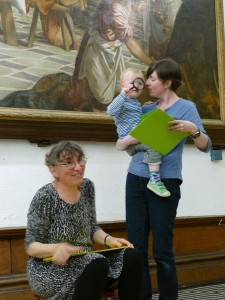
Children were presented with a folder of their Family Adventures and a magnifying glass to continue exploring with
Implications for the Shipley Art Gallery
Exhibition Explorers has proven to be a fascinating project for the Shipley Art Gallery. It has helped us to see the Shipley through children’s eyes – recognising that exploring the museum environment is just as important as what’s on display, for our youngest visitors. Having observed many of the project’s participants engage in ‘Creative Baby!’ and then progress to this project, we have gained an insight into young families’ evolving needs and preferences in museums as their children grow. Several of the families have become regular visitors to the Shipley, attending several times a month for various groups and activities, and exploring the gallery with confidence. It is apparent that the ways in which families engage, and their resulting perceptions of museums have been positively affected by this project.
At the end of the project, children were presented with a folder of their Exhibition Explorer Encyclopaedia scrapbook pages, and a magnifying glass with which to continue exploring museums and galleries (pictured below).
The project now continues into phase 2 which will run from July 2016 – February 2017. Approximately half of the families who took part in the pilot will continue, with the rest of the group consisting of people who are new to the project and / or the Shipley Art Gallery in general.
